Inkbit Launches Inkbit Vista Additive Manufacturing System
The automated 3D printing ecosystem features a closed-loop feedback control, multimaterial printing capabilities and low cost-per-part for final part production.

This new closed-loop feedback 3D printing ecosystem offers a platform based on scalable inkjet deposition and 3D machine vision. Image courtesy of Inkbit.
Latest News
February 23, 2021
Inkbit, a company that has built a 3D printer driven by vision-based feedback control, has launched its Additive Manufacturing System with Inkbit Vista. The closed-loop feedback 3D printing ecosystem offers a platform based on scalable inkjet deposition and 3D machine vision.
Inkbit Vista features the Vision-Controlled Jetting solution and multi-material design software, enabling manufacturers to bridge the gap between prototyping and full-scale production, company says.
Vision-Controlled Jetting (VCJ) takes additive manufacturing to production by enabling real-time, in-process voxel-level control to meet the reliability and performance demands of volume manufacturing. This technology converges advanced computational techniques with a scalable hardware architecture and materials chemistries inaccessible to incumbents. VCJ was developed at MIT and is protected by a strong IP portfolio exclusively licensed to Inkbit.
VCJ enables development of end-use products with high-performance polymers by:
- Optimizing in real time for accurate and reliable prints. Inkbit’s vision system allows the system to capture voxel-by-voxel 3D scan data of the print process at high-speed, modifying each layer in real time to ensure a perfect print.
- Simplifying and automating the full workflow. Vision-Controlled Jetting enables simple, fast and non-hazardous post-processing of parts and reduces costs associated with lost materials, labor and equipment. Inkbit’s technology can also integrate directly into existing manufacturing systems; with fully automated production, manufacturers can reduce cost-per-part and more efficiently scale production.
- Combining resin 3D printing precision with production-grade materials to move beyond prototyping. Until now, the most precise 3D printing technologies have all required the use of certain undesirable materials, which make parts brittle and weak over time. Inkbit’s technology allows these materials, called acrylates and methacrylates, to be completely removed, opening up a new field of high quality and long-lasting parts.
“We are thrilled to launch Inkbit’s Additive Manufacturing System and offer a unique, rapidly deployable 3D printing solution to companies looking to adopt digital manufacturing,” says Davide Marini, co-founder and CEO at Inkbit. “Today, engineers are often using 3D printing technology to make prototypes, but limitations in materials and high costs make end-use product production difficult. At Inkbit, we’re on a mission to disrupt that notion and create a technology that provides fast printing capabilities with unmatched design freedom and reliability for even the most demanding applications and environments.”
Inkbit was spun out of the Computer Science and Artificial Intelligence Laboratory (CSAIL) at MIT in 2017 and has since raised $15 million in equity investments from investors such as Stratasys, DSM Venturing, Ocado, 3M, IMA and Saint-Gobain. Inkbit also received funding from DARPA and NSF for the development of its core technology and applications in the medical field.
Inkbit Vista is available for pre-order today.
Sources: Press materials received from the company and additional information gleaned from the company’s website.
Subscribe to our FREE magazine, FREE email newsletters or both!
Latest News
About the Author
DE’s editors contribute news and new product announcements to Digital Engineering.
Press releases may be sent to them via [email protected].






